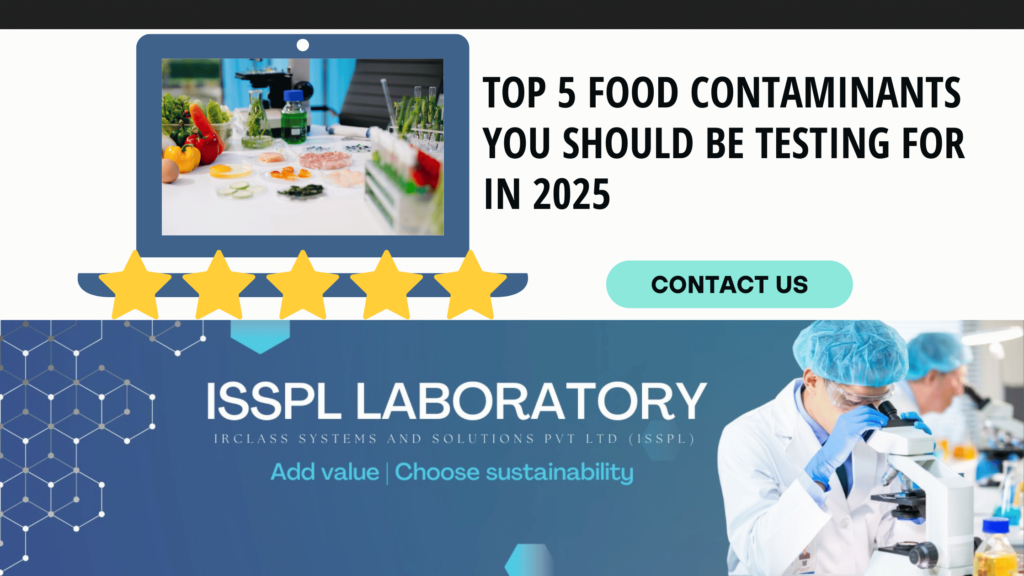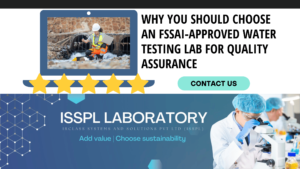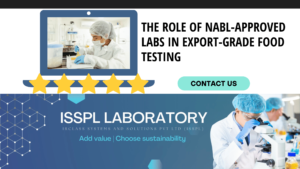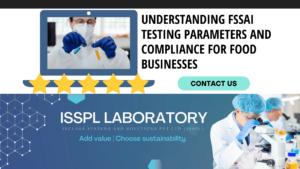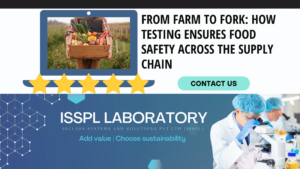An Overview by Team ISSPL - Analytical Testing Laboratory in India
ToggleTesting food is no longer about quality alone because it now connects directly to business risk, along with export readiness and supply chain trust.
If a batch fails even one critical parameter, the damage goes beyond a rejected shipment and can impact the brand, along with long-term market access.
In 2025, food producers and exporters need to track five key contaminants that are shaping the future of testing. Each one poses a serious risk if missed.
Pesticide Residues Are Still One of the Most Common Failure Points
Most crop-based products carry some pesticide residue if the soil or spraying process is not carefully managed across the growing and harvesting stages.
Governments across markets are setting tighter limits with shorter approval lists, which makes previous test reports unreliable for new export cycles.
Buyers now ask for multi-residue tests that cover dozens of compounds across categories such as insecticides, along with herbicides and fungicides.
LC-MS/MS and GC-MS/MS are the most used systems because they can screen for a wide range of pesticide types within a single testing cycle.
You also need to account for new restrictions on compounds that were once widely accepted but now face closer scrutiny across the European Union.
Heavy Metals Enter Through Water, Soil, and Storage Conditions
Metals like lead and arsenic may be present in the soil or water and can easily carry through the food chain without showing visible signs.
This type of contamination is often found in grains along with pulses and spices because these absorb metals during growth or storage phases.
Common test panels include lead, cadmium, arsenic and mercury, and some of them now need to be speciated to isolate the more toxic forms.
The instrument of choice is ICP-MS since it provides high sensitivity with low detection limits in a large variety of food samples.
Aflatoxins Are a Serious Concern for Exporters of Dry Foods
Aflatoxins form in certain fungi that grow in warm humid conditions often found during post-harvest storage of crops like peanuts and spices.
Once these toxins enter the product, they cannot be removed through washing or cooking, which makes early detection the only workable step.
Markets like the EU have extremely low tolerance levels, which makes aflatoxin testing one of the most critical checkpoints for exporters.
Lab tests cover different types of aflatoxins, such as B1, B2, G1, and G2, with each one contributing to the total toxin load in the final report.
Testing needs to be done at the batch level because mixing of lots can mask the presence of contaminated produce if sampling is not done carefully.
Microbial Contaminants Pose the Most Immediate Health Risk
The presence of bacteria or pathogens in food may cause severe disease in a few hours, and this aspect is very sensitive across categories.
Dairy, seafood, meat, and ready-to-eat meals are products that have a high risk when hygiene or temperature control is not applied in the preparation or storage process.
Common pathogens to be tested include Salmonella, Listeria, and E.coli, total plate counts, and yeast-mold in certain instances.
Lab testing usually involves the use of both the traditional culture methods and the new rapid kits that assist in screening quickly when dealing with perishable or short-life products.
The clear sampling plan is important since the majority of microbes are transmitted by contact, which implies that the issue may be in surfaces, as well as the food itself.

Antibiotic Residues Are Becoming a Major Compliance Issue
Antibiotics used in poultry or livestock production can remain in meat or dairy products if proper withdrawal periods are not followed during farming.
This becomes a regulatory problem because consumers may build resistance over time if exposed to such residues in their daily food intake.
Tests must now cover multiple antibiotic groups, such as tetracyclines, along with sulfonamides and fluoroquinolones, depending on the product type.
Some test kits use microbiological inhibition methods, but LC-MS/MS is preferred when trace-level confirmation is required for regulatory filing.
Meat, milk, and egg products are especially sensitive to this type of test because they are consumed widely and often with minimal processing.
Buyers Are Asking for More Than Just Test Results
The majority of buyers are no longer content with a simple test report and demand that the labs offer context, traceability, and sample-level assurance.
Labs should clarify how it was done, the detection limits, and the sample preparation to prevent confusion when third parties are viewing the lab or doing an audit.
Turnaround time is still important, but more customers are requesting digital reports, which enable them to store and search results between product lines.
The assistance of sampling plans and regulatory mapping has become a regular demand of the labs that collaborate with clients in all categories of exports.
This has seen increased emphasis on labs capable of handling large amounts without compromising accuracy of various types of contaminants and test limits.
Export Rules Are Changing Faster Than Most Producers Can Track
A few years ago, it was possible to meet one country’s standards and assume others would accept the same reports across similar parameters.
That approach no longer works because governments are setting market-specific rules and rejecting products that do not meet the exact test requirement.
Many clients now ask for separate tests for different markets because some buyers follow stricter rules even within the same product category.
This trend is especially visible in organic exports, along with nutraceuticals and spice shipments that pass Indian standards but fail at EU entry points.
Labs need to stay updated and communicate clearly about test types, report formats and risk areas before the sample is even picked up.
ISSPL Lab Helps You Test Right Before Your Product Leaves the Ground
ISSPL Lab supports clients by testing food products for pesticides, along with heavy metals and microbiological risks, under real-world market conditions.
They are approved by FSSAI, along with APEDA and NABL, which means they can handle export testing across most product types and destination countries.
With instrumentation like LC-MS/MS and ICP-MS, they offer trace-level detection for food categories such as spices, along with nuts and processed items.
Their team works with clients on planning test cycles so you can manage risk across raw materials, along with final product shipments, without last-minute panic.
If you want your products tested right the first time, ISSPL Lab helps you stay ahead of the rules without getting lost in the process.
FAQs
1. Why are pesticide residues still a concern even after washing or processing food?
Pesticides often penetrate deep into crops during farming which means washing or cooking does not remove them fully from the final product.
2. What kind of foods are most likely to carry aflatoxins?
Aflatoxins are most common in peanuts along with maize and spices especially when storage conditions allow moisture or fungal growth to build up.
3. Do all countries follow the same limits for contaminants in food?
No two countries follow the exact same standards because each market sets its own rules for contaminants based on local food safety regulations.
4. Why is heavy metal testing important for grains and spices?
Heavy metals like lead or arsenic may enter through water or soil and often stay trapped in dry goods such as grains along with spices.
5. What happens if a food product fails a microbiology test before export?
If a food product fails microbial testing it usually cannot be cleared for export and may require disposal or full batch recall before reshipping.
